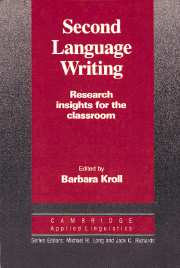Book contents
- Frontmatter
- Contents
- List of contributors
- Series editors' preface
- Preface
- Introduction
- I PHILOSOPHICAL UNDERPINNINGS OF SECOND LANGUAGE WRITING INSTRUCTION
- II CONSIDERATIONS FOR WRITING INSTRUCTION
- Chapter 7 Composing in English: effects of a first language on writing in English as a second language
- Chapter 8 The teaching of topical structure analysis as a revision strategy for ESL writers
- Chapter 9 What does time buy? ESL student performance on home versus class compositions
- Chapter 10 Feedback on compositions: teacher and student verbal reports
- Chapter 11 Teacher response to student writing: focus on form versus content
- Chapter 12 Responding to different topic types: a quantitative analysis from a contrastive rhetoric perspective
- Chapter 13 Writing with others' words: using background reading text in academic compositions
- Index
Chapter 9 - What does time buy? ESL student performance on home versus class compositions
Published online by Cambridge University Press: 05 October 2012
- Frontmatter
- Contents
- List of contributors
- Series editors' preface
- Preface
- Introduction
- I PHILOSOPHICAL UNDERPINNINGS OF SECOND LANGUAGE WRITING INSTRUCTION
- II CONSIDERATIONS FOR WRITING INSTRUCTION
- Chapter 7 Composing in English: effects of a first language on writing in English as a second language
- Chapter 8 The teaching of topical structure analysis as a revision strategy for ESL writers
- Chapter 9 What does time buy? ESL student performance on home versus class compositions
- Chapter 10 Feedback on compositions: teacher and student verbal reports
- Chapter 11 Teacher response to student writing: focus on form versus content
- Chapter 12 Responding to different topic types: a quantitative analysis from a contrastive rhetoric perspective
- Chapter 13 Writing with others' words: using background reading text in academic compositions
- Index
Summary
Writing is frequently a difficult skill for any language user, which is to say that writing presents a fairly challenging task for both native and nonnative speakers. For English as a second language (ESL) students, it seems fair to say that writing academic papers is particularly difficult. ESL students must learn to create written products that demonstrate mastery over contextually appropriate formats for the rhetorical presentation of ideas as well as mastery in all areas of language, a Herculean task given the possibilities for error. It is partially the multiplicity of skills involved which contributes to the overall difficulty of writing. Collins and Gentner (1980) make the following observation about native-speaker writing:
Much of the difficulty of writing stems from the large number of constraints that must be satisfied at the same time. In expressing an idea the writer must consider at least four structural levels: overall text structure, paragraph structure, sentence structure (syntax), and word structure.…Clearly the attempt to coordinate all these requirements is a staggering job. (p. 67).
If various aspects of writing are seen as “structural levels” that must be coordinated, it is reasonable to hypothesize that success may vary from level to level. For example, one particular student might exhibit greater mastery over sentence structure while another might exhibit greater mastery over overall text structure. Further, because of the particular difficulty that ESL students may have with the code of English (as partially predicted by principles of cognitive theory; McLaughlin 1987: 133–142), extending the amount of time allotted to producing an essay might affect the level of mastery exhibited on any or all of the levels identified by Collins and Gentner.
- Type
- Chapter
- Information
- Second Language Writing (Cambridge Applied Linguistics)Research Insights for the Classroom, pp. 140 - 154Publisher: Cambridge University PressPrint publication year: 1990
- 37
- Cited by

